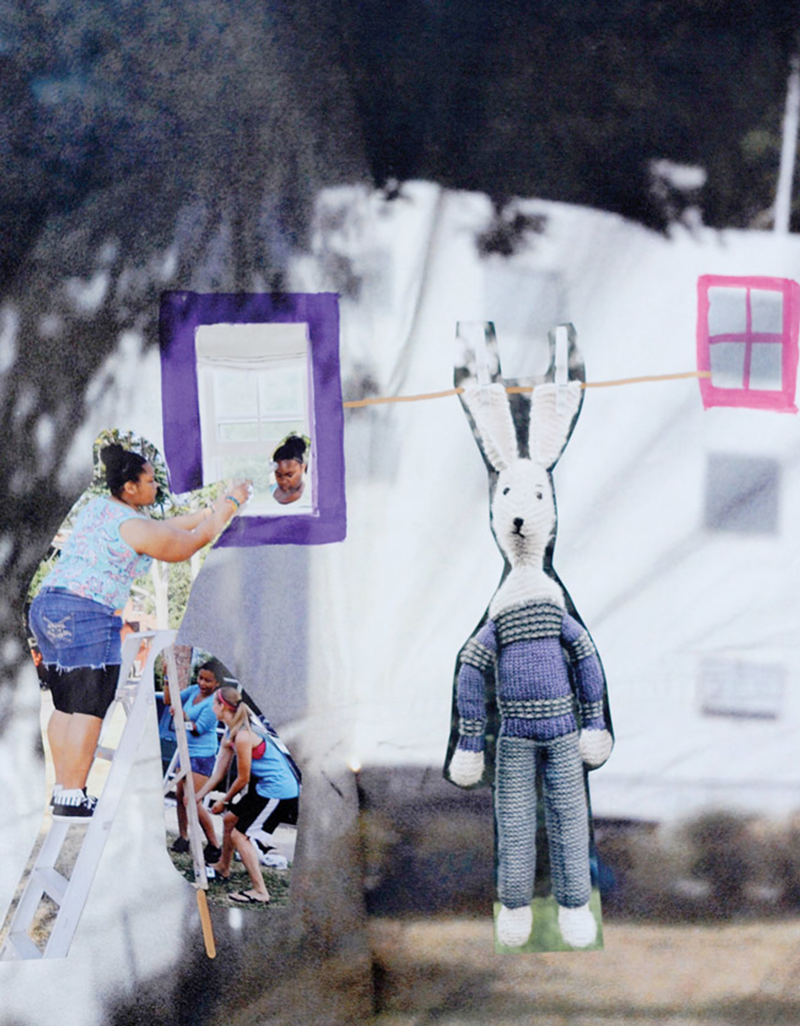It’s appropriate that Project Obscura at Northside’s Prairie Gallery opened before FotoFocus officially kicks off Oct. 5. After all, the camera obscura (Latin for “dark chamber”) led to the modern camera.
In addition , Project Obscura taps the creativity of kids as young as 4. FotoFocus exhibits featuring Herb Ritts, Andy Warhol and Edward Steichen will come later. Until then, why not begin with the beginning?
Prairie’s David Rosenthal brought a mobile camera obscura to nine community groups, most serving children. “How many have been inside a camera?” Rosenthal likes to ask. Project Obscura’s collapsible 12-by-12-by-8-foot-high booth is basically a large pinhole camera. Four 12-by-8-foot stud walls support 100 pounds of light-tight fabric, with a hole on one side. (A smaller walk-in version is inside the gallery.) Outside light shines through the aperture and projects the external scene on the back wall, but upside-down due to refraction. The concept dates to about 400 B.C.
Each group chose a site and pose to represent it. Rosenthal, a photographer and educator, largely stepped back. “The kids were the artists,” he says. Using a digital camera in the dark booth, he shot sections of the back wall to assemble into each finished image.
A camera obscura presents “an open-ended project full of creative possibilities,” Rosenthal says. Due to the primitive nature of the contraption (and the need to hold a pose for a two-minute exposure), these are shadowy, mystical images — out-of-focus yet evocative.
In most cases, mixed media — magazine clippings, crepe paper, paint, marker, photos documenting the shoot — were added to enhance the image, include more participants and encourage individual expression.
Sometimes the camera obscura image is lost under the decoration. Thankfully, a smaller untouched image is displayed by each piece. But even if the pictures are obscured, themes of love, hope, fun and inspiration are clear.
A common message is that, despite adversity, these kids enjoy the same things as any other kids. That’s why homeless students from Faces Without Places decided to pose as zombies. Children from Over-the-Rhine Community Housing took digital portraits of one another after their group session and listed their likes — Xbox, pizza, hot wings — in the captions. “I like this picture of me because it’s beasty,” says shirtless Izaiah, 6. Rees E. Price Academy students added poems. “I am from basketball island, Spalding and Nike. I am from Thanksgiving dinner,” one writes. Another says: “I am from being hyper and messing with my hair, from being called chunky to being called beautiful.”
“Contemporary art, when working well, pushes the boundaries of art-making,” says Rosenthal. “I don’t care who’s doing it … the final product is what matters. I’m interested in communities coming together.”
In such an undertaking, there are “real highs and things that don’t work,” Rosenthal says. “But if I dictate too much, I never get the highs.”
Among the highs is the composition from the children sitting on the Ronald McDonald House steps. “It’s symbolic to walk through that door,” says Rosenthal. “It’s about relief, a place where you can feel comfortable.” A resident whose head brace prevented her from talking added word bubbles to the image. A red marker brings out a smile on another girl’s face. Above is text from a magazine: “It could be you!” Is it a reminder that illness could hit any of us or, just as likely, an optimistic message that anyone could become a superstar?
The camera obscura experience lends itself to poetic thoughts. “After I stepped inside, while waiting for my eyes to adjust, I felt like a caveman discovering fire,” says Bill Ross, co-founder of the Thunder-Sky gallery for artists with disabilities. Antonio Adams and fellow artist Michael A. Weber posed at downtown’s casino site in memory of “construction clown” Raymond Thunder-Sky, who was inserted into the finished image as if appearing in a dream.
Bonus work from Sycamore High School photography teacher Peiter Griga also uses the camera obscura to mine memory. Griga takes the device’s ghostly effects further by using honey for his photographic emulsion and fixing the image in beeswax. The photos look like antiques discovered in an attic after a catastrophe. Griga’s materials not only produce scent — a powerful memory trigger — but the honey also sweats and crystallizes, constantly transforming his portraits.
Already shadowy images appear to fade. “Yet something remains within,” the accompanying text points out, “like a memory.” Or, in the case of Project Obscura ’s communities, a resilient spirit.PROJECT OBSCURA
is on view through Nov. 3 at Prairie Gallery (prairiecincinnati.com) in Northside.


